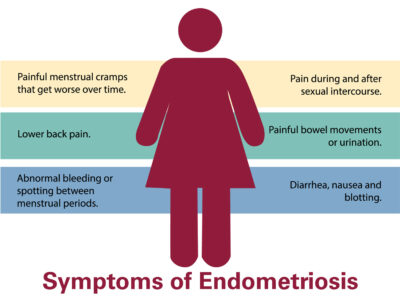Endometriosis
Overview
- Endometriosis occurs when tissue that lines the inside of the uterus grows outside of the uterus or on the ovaries, fallopian tubes, bowels or tissues holding the uterus in place.
- An estimated 6.3 million women in the U.S. experience endometriosis, which is the leading cause of infertility worldwide.
- Endometriosis affects mostly younger women of reproductive age (15-45), with general symptoms of pain in the pelvic area, lower back and abdomen.
What is endometriosis?
Endometriosis results when the endometrium, which is the tissue that lines the inside of a woman’s uterus, grows outside of the uterus. This tissue continues to act as it normally would inside the uterus, responding to the menstrual cycle by breaking down, thickening and bleeding.
The tissue that has broken down rarely spreads beyond the pelvic region and most commonly affects the ovaries, bowels, fallopian tubes and the tissue lining the pelvis. It is in this region that endometriosis can cause pain, particularly during a woman’s period.
Causes of endometriosis
Scientists have not concluded exactly what causes this condition. Possible explanations include:
- Retrograde menstruation, which occurs when menstrual blood containing endometrial cells does not flow out of the body as it normally should but stays in the body, flowing through the fallopian tubes into the pelvic cavity.
- Physicians think the hormone estrogen makes it worse because when women with endometriosis experience menopause, which reduces their level of estrogen, the endometriosis symptoms often cease.
- Immune system dysfunction may prevent a woman’s body from recognizing that endometrial cells are growing outside the uterus and thus fail to destroy them.
Endometriosis symptoms
Not every woman with endometriosis experiences symptoms, so a woman may have it and not know it. However, pelvic pain is the most common symptom and can become more pronounced during menstruation.
Types of pelvic pain include:
- Painful menstrual cramps that get worse over time
- Lower back pain
- Pain during and after sexual intercourse
- Painful bowel movements or urination
Other symptoms may include:
- Abnormal bleeding or spotting between menstrual periods
- Diarrhea, nausea and blotting
- Infertility
Endometriosis treatment
Unfortunately, endometriosis cannot be cured. Since it tends to spread progressively, treatments that can reduce or eliminate symptoms should begin as soon as it is diagnosed.
Medications or surgery can be used to treat symptoms. Your physician can tell you what treatment is best for you, depending on the extent of your condition and other health factors.
Medications
Over-the-counter pain relievers such as ibuprofen can ease pelvic pain and painful menstrual cramps. Therapy to reduce hormone levels, particularly levels of estrogen, may reduce pain from endometriosis.
Taking hormonal contraceptives for this reason can make endometrial lesions fade away, but symptoms most often return after the hormone treatments are stopped. Contraceptives are not an effective treatment for women with endometriosis who are trying to get pregnant.
Surgery
Minimally invasive surgery, such as laparoscopy, can remove or destroy endometrial lesions. Women who receive this treatment are usually still able to bear children. However, it is important to consult with a reproductive endocrinologist about your goals with managing endometriosis and becoming pregnant in the future to ensure the best treatment is pursued.
In severe endometriosis cases, a total hysterectomy that removes the uterus and cervix may be performed, but hysterectomy is normally considered a last resort and would eliminate the ability to carry a pregnancy.
